Sustainable Future
永續未來
CTCI First in Taiwan to Gain Certification to ISO 45001:2018 Standard for Occupational Health and Safety Management
— SGM Daniel Hsin-I Ting, HSE Management Dept., CTCI Corp., Group Engineering Business
While expanding international business, CTCI always highly values the health and safety of our employees. Beside consulting to external experts, learning from benchmarks in the industry and paying close attention to the international trends, we especially strive to make our HSE management mechanism even better. In April 2018, CTCI has become the first corporation in Taiwan to be certified to ISO 45001:2018, the first global standard published by International Standard Organization governing Occupational Health and Safety (OHS) Management. The global engineering, procurement, and construction services provider was certified the certificate by British Standards Institution. The ISO 45001:2018 certification is the latest recognition of the company’s commitment to the health and safety of its employees. In 2006, CTCI was certified to OHSAS 18001 (Occupational Health and Safety Management System). It also received ISO 14001 (Environmental Management System) certification that same year. The latest certification not only shows CTCI’s commitment to meeting the latest international OHS standard but also demonstrates its delivering on its “Most Reliable” brand spirit in the area of continual OHS improvement as well.
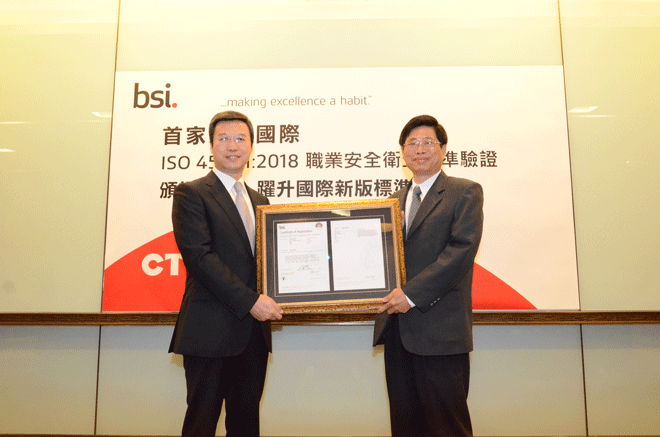
CTCI Group Shared Services CEO, Ming-Cheng Hsiao receiving the ISO 45001 Certificate from British Standards Institution (BSI).
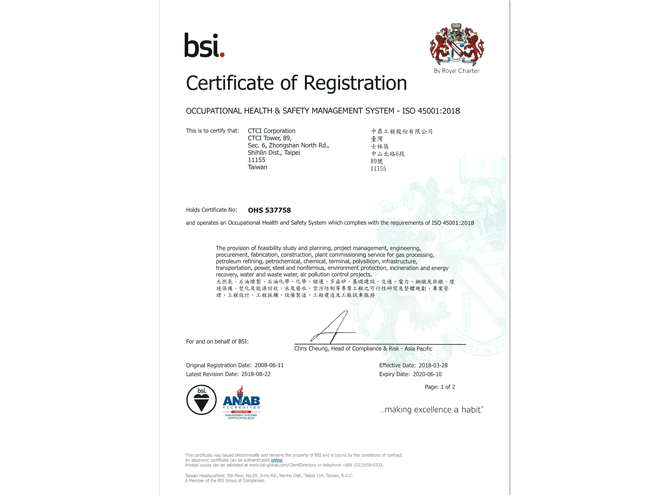
CTCI’s ISO 45001:2018 Certificate
ISO 45001 Background
With globalization, automation, intelligentization, emerging technologies, and rapid change in industries and jobs, OHS is much more complex than ever today. Many OHS management concepts and methods developed for traditional manufacturing and heavy industries are not applicable to office-based and service jobs, which account for the majority of jobs around the world. As the first global OHS management system standard, ISO 45001 not only meets the needs of traditional industries but also those from emerging industries. Furthermore, it also considers different societal characteristics and business cultures around the world. ISO 45001 takes a risk-based approach⁽¹⁾ that makes organizations define the scope of their management system after considering internal and external factors related to the health and safety of workers according to its context. This way, it allows all types of organizations to apply the standard, regardless of industry, size, and business model. ISO 45001 adopts the common ISO framework, High Level Structure, to develop its main management elements, including Context of the Organization, Leadership and Workers’ Participation, Planning, Support, Operation, Performance Evaluation and Improvement, and these elements are operated based on the concept of Plan-Do- Check-Act (PDCA) to achieve continual improvement. In addition, there are other popular standards such as ISO 14001, ISO 9001, and ISO 27001 that adopt High Level Structure; since they all have the same structure, organizations can easily integrate these management systems and increase the efficiency of implementation.
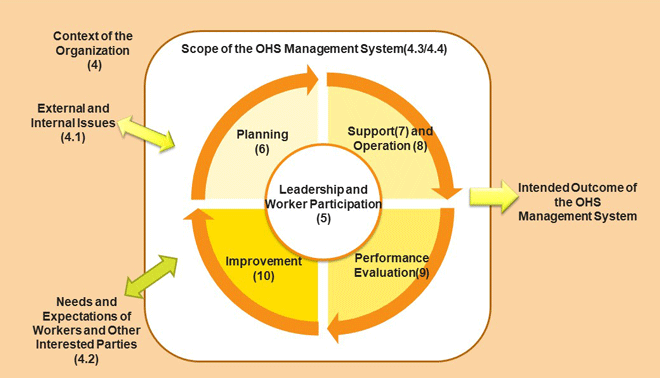
PDCA Cycle of ISO 45001:2018
ISO 45001 Practices in CTCI
A.Context of the Organization
ISO 45001 is different from the OHS management standards developed in the early days; it emphasizes both internal and external factors. There is no organization which can completely ignore the external environment and operate solely. Industry developments, market trends, regulatory legislation, the value chain and public opinion each has a direct or indirect effect on the internal operations of an organization. Therefore, ISO 45001 make each organization start by understanding its own context, including internal and external issues, and use this as the foundation for developing its own OHS management system. CTCI’s projects are located around the world and are characterized by both massive project size and a matching number of suppliers. Consequently, there are a large number of external factors. In order to grasp those factors that might affect OHS performance, we identify the significant OHS issues according to the corporate business, organizational structure, operation strategy, management mechanism, OHS performance and the needs and expectations of stakeholders identified in our CSR report. We then compile these factors into the “Corporation Organization Context Review Report (Attachment 1 of the HSE Manual)” for determining the scope of the management system and identifying risks and opportunities.
B.Leadership
In order to effectively promote OHS management system in an organization, top management must take an active role and demonstrate their leadership. ISO 45001 list 13 duties top management shall fulfill to comply with the standard. Besides ensuring the policy, objectives and requested processes are established, providing resources, communicating, directing and supporting, the list includes top management’s “developing, leading and promoting a culture in the organization that supports the intended outcomes of the OHS management system”. In short, building a robust health and safety culture. In order to cultivate such a culture, in addition to various promotional activities, CTCI clearly defines “safety first” as one part of our culture. In 2018, we held CTCI HSE Week for the first time, showing our determination to raise employees’ HSE awareness and promote company-wide engagement. Top management of CTCI also regularly conducts health and safety seminars for each level of management. Moreover, they visit construction sites in person whenever necessary to have direct contact with front-line workers, increasing the visibility of leadership and making CTCI employees and subcontractors feel that their health and safety are valued seriously.
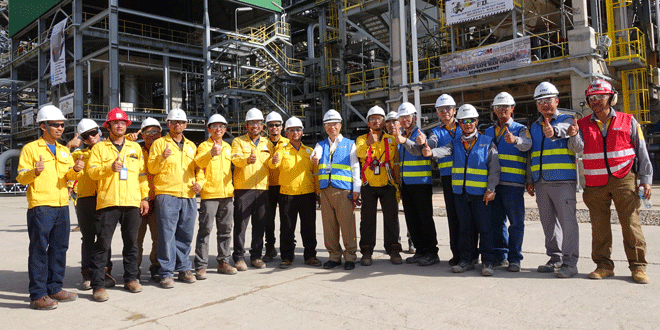
CTCI Group Chairman John T. Yu visited construction site.
C.Consultation and Participation of Workers
Keeping the work environment safe is not just the responsibility of the employer, management or OHS personnel, but also that of every worker. Company-wide engagement is one of the key notions of ISO 45001. It requests organizations to emphasize the consultation and participation of workers in the development, planning, implementation, continual improvement of the OHS management system. This helps to avoid any negligence of execution details of activities or work not previously considered. The standard lists nine items that organizations shall consult with non-managerial workers and seven items that organizations shall let non-managerial workers participate in. In CTCI headquarters, after considering the complexity of the organization and related risks and balancing the effectiveness of the mechanism and operational efficiency, we ask every department to assign a person who must be familiar with the departmental business, work processes and environment, to be the departmental representative for the mechanisms of consultation and participation. In construction sites, front-line workers would report unsafe behavior through the behavior observation activity and site management would address high-risk work and conduct improvement measures after analyzing data. Other mechanisms and activities for demonstrating consultation and participation of workers in CTCI include: safety moment conducted before meetings, employee suggestion platform (for Facility Management, Proposals to Improve, Suggestions, Report of Violation of Ethical Code or Rules of Business Conduct, and Physical/ Psychological Infringement Report), various symposiums and anonymous questionnaires.
D.Hazard Identification and Risk Assessment
ISO 45001 takes a risk-based approach to OHS management. It requests organizations to identify hazards of the activities, products and services they can control or influence and assess their risk, then establish control measures according to their risk level. Furthermore, occupational health issues and social factors, such as workload, work hours, victimization and harassment, which received less attention before, are included in the risk assessment scope in ISO 45001. In CTCI, the project execution process is divided into four stages: engineering design, procurement, construction, and commissioning. In addition to applying different methodologies to assess risks existing at each stage, we conduct a constructability review and process safety assessment at the design stage in order to prevent incidents from occurring in construction and operations. Furthermore, for works conducted by subcontractors and in places that CTCI is unable to control, we assess their risk according to the characteristics of the works (such as using dangerous machines or not) and the characteristics of the subcontractors (such as whether it has an established OHS management system or not). After that, we control moderate- to high-risk work through purchase specifications, contractual requirements or subcontractor qualification since we cannot directly control the work arrangements.
E.Procurement Management
A corporation might incur legal, financial and reputational impact when there is an OHS incident in its supply chain. Nowadays, the factors affecting supply chain OHS are extremely complicated due to globalization, making related risks harder to identify and manage. A solid foundation and continual improvement over time can reduce this difficulty and adherence to ISO 45001 can provide these two capabilities⁽¹⁾. CTCI has a massive supply chain with diverse vendor types. Even though on-site works are mostly done by local subcontractors, materials, equipment and modules are usually transported from other countries. In order to effectively manage this complex supply chain, we control it at source. All vendors are required to pass a document review or shop visit before they are registered as an approved vendor. When executing the procurement process, project teams select vendors from the Approved Vendor List and then conduct a technical bid evaluation to ensure that the selected venders meet OHS requirements and have the required ability in OHS management. For vendors we have worked with, project teams evaluate their performance during contract execution and at contract completion. These evaluation results will be taken as references for future vendor selection. CTCI held a Supplier Meeting in 2018 to communicate CTCI HSE Policy with suppliers and motivate them to put more effort into HSE management.
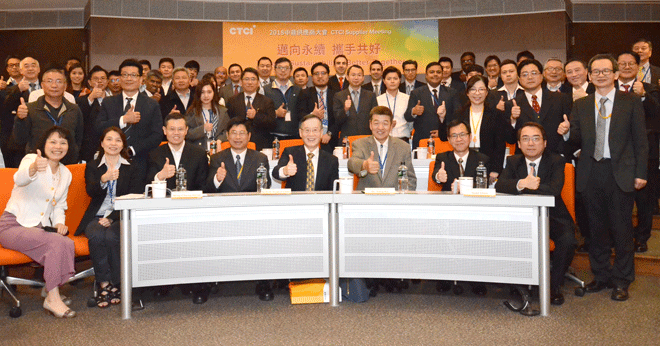
CTCI communicated its CSR policy to suppliers in the 2018 Supplier Meeting.
Continually Improving Management Mechanisms
CTCI has projects around the world and provides a diverse range of services. Consequently, the local culture, regulatory and legislative framework, and supply chain involved are complex and constantly changing. We understand that in this constantly changing world, only with continual improvement can we effectively address upcoming risks. Certification to ISO 45001 is just one of the milestones in our OHS management journey, and only by continually optimizing our management mechanism can we fulfill our commitment to protect the health and safety of our workers.
Reference 1.Gasiorowski-Denis, E. (Ed). (2018) Health and Safety at work: Are you ready for ISO 45001. ISO Focus, 127.
